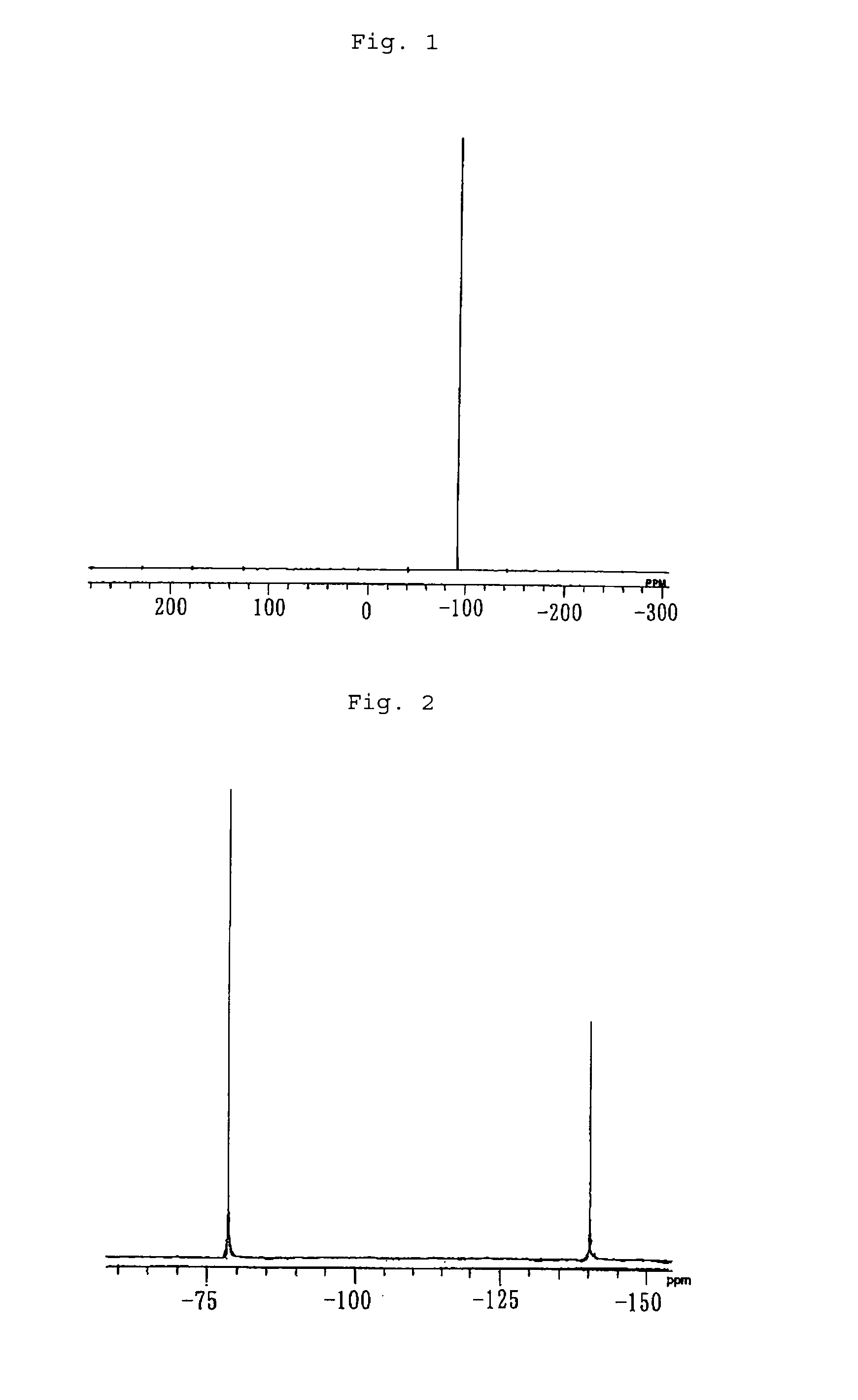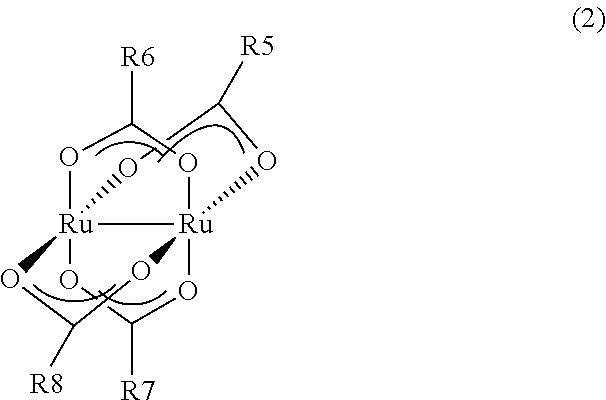Diruthenium complex, and material and method for chemical vapor deposition
- Summary
- Abstract
- Description
- Claims
- Application Information
AI Technical Summary
Benefits of technology
Problems solved by technology
Method used
Image
Examples
example 1
Synthesis of tetra(μ-acetato)diruthenium(II,II)
[0038]2.0210 g of ruthenium trichloride•trihydrate, 0.0138 g of an Adams oxidation platinum catalyst and 25 mL of methanol were stirred in an autoclave under a hydrogen pressure of 6 atm for 3 hours to obtain a blue solution. After the end of stirring, the resulting solution was filtered and transferred to a Schlenk flask whose inside had been substituted by nitrogen, 2.3580 g of lithium acetate was added, and the resulting mixture was heated to reflux for 18 hours. After the end of the reflux, thermal filtration was carried out, and the filtrate was washed with methanol 3 times and vacuum dried at 80° C. to obtain 0.9207 g of tetra(μ-acetato)diruthenium as a brown powder. The yield was 54%.
[0039]When the elemental analysis of the obtained solid was carried out, the solid had a carbon content of 21.91% and a hydrogen content of 2.70%. As for the theoretical values of tetra(μ-acetato)diruthenium, the content of carbon was 21.92% and the ...
example 2
Synthesis of tetra(μ-trifluoroacetato)di(acetone)diruthenium(II,II)
[0041]0.9059 g of tetra(μ-acetato)diruthenium, 1.696 g of sodium trifluoroacetate, 28 mL of trifluoroacetic acid and 4 mL of trifluoroacetic anhydride were fed to a Schlenk flask whose inside had been substituted by nitrogen, and the resulting mixture was heated to reflux for 3 days. After the end of the reflux, filtration was carried out to obtain a cardinal solution. The solvent was distilled off in a vacuum, and extraction was carried out with ether. Vacuum distillation was carried out again, recrystallization was carried out by using acetone, and the obtained product was washed with hexane and vacuum dried to obtain 1.3517 g of tetra(μ-trifluoroacetato)di(acetone)diruthenium as a purple-red solid. The yield was 65%.
[0042]When the elemental analysis of the obtained solid was carried out, the solid had a carbon content of 22.19% and a hydrogen content of 1.62%. As for the theoretical values of tetra(μ-trifluoroacet...
example 3
Synthesis of tetra(μ-pentafluoropropionato)di(acetone) diruthenium(II,II)
[0045]100.4 mg of tetra(μ-acetato)diruthenium, 194.1 mg of sodium pentafluoropropionate, 3.6 mL of pentafluoropropionic acid and 0.4 mL of pentafluoropropionic anhydride were fed to a Schlenk flask whose inside had been substituted by nitrogen, and the resulting mixture was heated to reflux for 3 days. After the end of the reflux, filtration was carried out to obtain a cardinal solution. The solvent was distilled off in a vacuum, and extraction was carried out with ether. Vacuum distillation was carried out again, recrystallization was carried out by using acetone / hexane, and the obtained product was washed with hexane and vacuum dried to obtain 122.4 mg of tetra(μ-pentafluoropropionato)di(acetone)diruthenium as a purple-red solid. The yield was 55%.
[0046]When the elemental analysis of the obtained solid was carried out, the solid had a carbon content of 22.56% and a hydrogen content of 1.53%. As for the theore...
PUM
 Login to View More
Login to View More Abstract
Description
Claims
Application Information
 Login to View More
Login to View More - R&D
- Intellectual Property
- Life Sciences
- Materials
- Tech Scout
- Unparalleled Data Quality
- Higher Quality Content
- 60% Fewer Hallucinations
Browse by: Latest US Patents, China's latest patents, Technical Efficacy Thesaurus, Application Domain, Technology Topic, Popular Technical Reports.
© 2025 PatSnap. All rights reserved.Legal|Privacy policy|Modern Slavery Act Transparency Statement|Sitemap|About US| Contact US: help@patsnap.com



